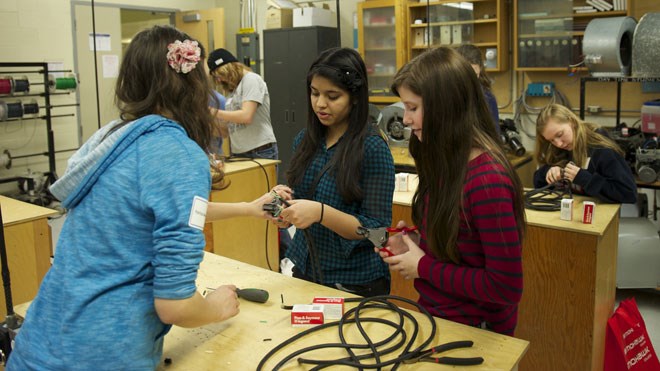Canada's labour shortfall could reach nearly one million workers by 2020, according to the Conference Board of Canada.
The skilled trades are expected to represent a big chunk of that shortfall. To help mitigate the impact on the economy, and empower unemployed and underemployed women in Ontario, the Women in Trades Forum will make the case for the trades in Sudbury on March 5.
According to a Skills Canada Report in 2011, women represented less than three per cent of trades jobs in Canada that year.
Jane Wilson, director of women services with Microskills Development Centre, and a founding member of the Women in Trades Network, said the numbers have not improved much since 2011.
“We have serious issues if we are not equipping 50 per cent of our workforce with the skills for where our jobs lie,” Wilson told Northern Life. “If women are not employable, then we as a society are still covering the costs of maintaining individuals who are not employable.”
Skilled trades, such as carpentry, electrical and welding, pay well and can lead to rewarding careers, said Wilson.
“The trades open so many doors in so many different directions for women that it's important to take a holistic look at all the opportunities that come when a person invests in the labour force,” she said.
The Women in Trades Network started its series of trades forums in 2010 to help remove the barriers it says prevents women from entering the trades.
One of those barriers, said Wilson, is the traditional methods to get people into the trades are not working for women.
Typically, a potential tradesman presents himself to an employer for on-the-job training. But for women, Wilson said, classroom learning prior to an apprenticeship has proven to be a more effective path.
She cited an example at Ottawa's Algonquin College, where the school has partnered with Hydro One to offer an electrical technician and technologist program tailored specifically for women.
The program combines the first and second year of the program, followed by an internship with Hydro One and the continuation of the second year after the hands-on experience.
It isn't a lack of interest either that's keeping women from entering the trades, Wilson said. “They're interested. They want to be there but they need assistance, they need encouragement and they need role models and mentors.”
Stigma has also acted as a barrier, added Reggie Caverson, executive director of Sudbury and Manitoulin Workforce Planning.
She said some trades employers have started to welcome women, but many others haven't.
Sudbury and Manitoulin Workforce Planning is one of the organizers of the Sudbury Women in Trades Forum, scheduled for March 5 at Collège Boréal.
The event will feature hands-on opportunities for attendees to try out one of six in-demand trades — carpentry, electrical, welding, millwright, heavy equipment technician and automotive technician.
A bilingual instructor from Collège Boréal will help participants along with the experiential learning.
A contingent from Manitoulin Island is expected to attend the forum, where there will be a focus on efforts to involve more Aboriginal women in the mining industry.
@jmigneault
Join Sudbury.com+
- Messages
- Post a Listing
- Your Listings
- Your Profile
- Your Subscriptions
- Your Likes
- Your Business
- Support Local News
- Payment History
Sudbury.com+ members
Already a +member?
Not a +member?
Sign up for a Sudbury.com+ account for instant access to upcoming contests, local offers, auctions and so much more.
